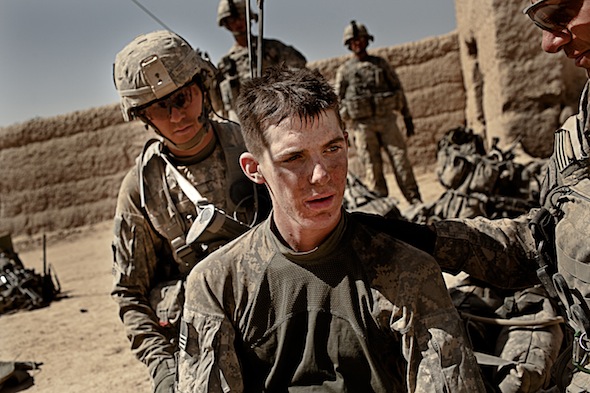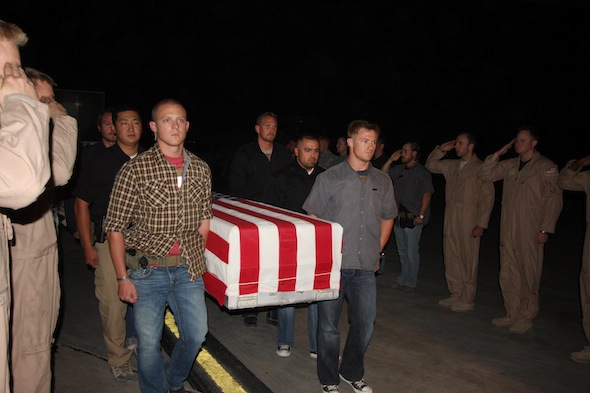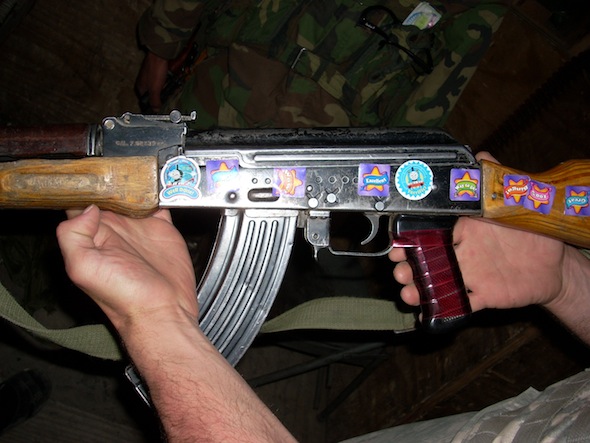
About halfway through America’s decade-long intervention in Iraq, Ashley Gilbertson sensed war fatigue. The celebrated VII photographer, who won the 2004 Robert Capa Gold Medal from the Overseas Press Club for his coverage of the battle for Fallujah, noticed a difference, as the years accumulated, between the conflict he knew firsthand and the country as depicted in American public discourse.
“I was working a lot in Iraq,” he says, “and I would come home to find that as the war dragged on, people were less and less engaged with what was happening over there.”
By 2007, Gilbertson felt compelled to portray the suffering he thought Americans weren’t seeing, so he took his camera to soldiers’ funerals, to American cemeteries, and local memorials. But even those pictures didn’t grab what Gilbertson wanted to convey about whom America had lost in the conflict. “That was about the people who were living, rather than the absence of those who had died,” he says.
Gilbertson struggled to find a language for the intimacy and depth of of loss. His wife Joanna, a writer, struggled with him. “I always felt like no matter what pictures anybody was shooting of war, they were shooting soldiers. I can’t identify with a soldier,” she says. One day, as the two looked at soldiers’ portraits in The New York Times, his wife hit on the idea he would ultimately pursue. “You need to photograph their bedrooms,” she told Gilbertson.
So he spent the next six years traveling around the country, visiting with the parents of soldiers who died, documenting their private spaces in Bedrooms of the Fallen, which will appear next spring, on Memorial Day, as a book. “You find something in each of these rooms that relates to you and your understanding of life,” Gilbertson says. “And through that object or point in the room, the rest of the room”–and, he hopes, the life of the lost soldier who lived in it–“will open up to you.”
Gilbertson is not the only photojournalist to experiment with new ways of opening up the war for an allegedly beleaguered American public that thinks it knows the war story: more than 6,700 dead, over nearly 12 years, in Iraq and Afghanistan. Among photojournalists’ new books, exhibitions, and public engagement projects, there’s a critical commonality: the desire to establish a new visual vocabulary of conflict.
Photojournalist Michael Kamber, who covered the war in Iraq from start to finish for The New York Times, felt the war was in fact uglier and more difficult than the images he was able to bring back home.
“I was butting heads constantly with the US military, and they were trying to stop myself and my colleagues from getting access from certain situations, [from] publishing photos of wounded and dead soldiers,” Kamber says. “I felt like a number of institutions, for lack of a better word, came together to prevent the American people from understanding what that war looked and felt like.”

Kamber includes news outlets and their photo editors among those institutions. “I think photo editors were absolutely crucial in shaping the narrative in the image of the Iraq war in the public’s mind, and frankly I feel that many of them failed,” he said. Kamber spent years feeling censored by the stylistic choices of mainstream publications.”When [news outlets] published pictures of wounded soldiers, they were generally limping off the field of battle as if they were at a football game or something, and that’s not what the war looked like.”
In May, Kamber released Photojournalists on War: The Untold Stories from Iraq, a visual and narrative oral history of photography from the 10-year fight in Iraq, published by the University of Texas Press. Kamber interviewed 39 of his colleagues and published images their employers never had. The result is a visual and written document that shows the war as it hasn’t been seen before this.
“I think I was trying to tell, in a nutshell, the truth about the Iraq war; I felt like it was a truth that… really wasn’t out there,” Kamber says. But it’s not a truth readers necessarily want to hear–or pay for. “We’ve gotten incredible press on the book, dozens and dozens of articles–we’ve been on television repeatedly–and yet the book doesn’t sell at all,” he says.
Nicole Tung, a freelancer who’s covered the conflicts in Libya and Syria, says the constraints of war imagery that inspired Kamber’s book cross into the conflicts she’s covered, too. Tung specializes in documenting the effects of violence on civilians’ lives but argues that even the most celebrated pictures of these places “have been really monotonous. The pictures that get awarded are the bang-bang pictures, the ones with guys with guns. It’s been a little bit frustrating, because the wars and revolutions have been so much more complex than that.”
Even guys with guns can be more complex than the media treatment they usually receive. Robert Nickelsberg has been covering Afghanistan since 1988 and lived in the region for 12 years. His own photo work begins on film, with the Soviet Army’s withdrawal from the country in the late 1980s. The withdrawal, and the Cold War that followed, are universally recognized as critical historical prologue to the American war in Afghanistan, but it’s virtually invisible in contemporary journalism about US involvement there.
“The majority of working journalists went [to the region] after 9/11,” says Nickelsberg. “I could see how precarious and superficial that approach is, often reinforced by embeds and inexperienced embassy people…who didn’t know their ass from their elbow, even though they had various advanced degrees. If you didn’t know South Asia or Pakistan pre-9/11, good luck with a complicated conflict like that.”
Nickelsberg’s new book, The Distant War, is a visual chronology of conflict in Afghanistan, stretching back before American involvement and featuring Afghan voices. Making the book “was also clarity for myself, breaking it down year by year…[I] happen to catalog more than 20 years,” says Nickelsberg (who will be discussing his book in New York City on November 11 at 7pm).
Though this was a story that hadn’t been told this way, with visual resources no one else had, Nickelsberg couldn’t find an American publisher. He brought the book out with German publisher Prestel. In fact, visual journalists say, there’s a presumption that books like Nickelsberg’s or Kamber’s won’t sell. “And they are correct about that,” says Kamber, who raised some of the money needed for his 5,000-print run, with a small university publisher, by selling signed and numbered limited editions in advance. Nickelsberg’s project had support from Queensborough Community College; Erin Trieb, founder of “The Homecoming Project,” a photo project about veterans, used Kickstarter to raise the first round of funding for Homecoming (her second Kickstarter begins this week).
American book buyers may have more tolerance for words about war than for pictures of it. David Finkel‘s two narrative nonfiction books about Iraq have been more easily received. The Good Soldiers won critical acclaim and shortly thereafter, Finkel won a MacArthur “genius” award. That book, Finkel says, “did very well” in sales, well enough that he had no trouble getting a contract for the sequel, Thank You For Your Service, published last month. But Finkel points out that his subject, especially in the second book, isn’t, in fact, the war. Instead, he chronicles “what happens to young men sent into war at a particular time, when all seems lost…to use war to write about the character[s] of young men.”
The changing lives of young men (and women), especially when they return from battle, are at the heart of Trieb’s “Homecoming Project.” Trieb’s documentary effort collects not only her photographs from Iraq and Afghanistan, but also the photos and writing of veterans and their families, with a particular focus on the expression and effects of post-traumatic stress disorder. Unlike many journalists, who interpret their role as documenting without commentary, Trieb wants to engage her audiences for action.
“For me to photograph and document a story on post-traumatic stress disorder and have it published in major news magazines, and then to see the lives of the veterans in my story have not been altered in the least … it definitely was disheartening,” she says. “I wanted to initiate change, even if it was just for a few families.”
But Trieb doesn’t believe that photojournalism as traditionally understood offers those tools today. “This isn’t the age of [James] Nachtwey, where your picture might run on the cover of Time magazine and then millions of dollars are sent to Somalia in aid,” she said, by way of example. “As journalists, what’s our social responsibility to the people we cover or photograph?”
Though not every war-journalist-turned-documentarian shares Trieb’s desire to prompt action on behalf of veterans, the need to make visible the human cost of war, in a way that engages the public, rings nearly universal–and not just in the moments journalist are on the job.
“At some point, to me as a consumer of news, the numbers and policies start getting a little blurry,” Finkel says. “If I do it thoroughly enough,” he hopes, “the numbers not only get a face … [they] become quite real.”
Jina Moore was a 2013 New Media Fellow of the International Reporting Project

